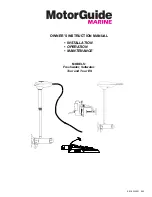
UG-1673
Rev. 0 | Page 18 of 29
LAYOUT GUIDELINES
BOARD STACKUP
The EVAL-ADIN1200FMCZ consists of a 4-layer PCB. The
layers include the top layer, Layer 2, Layer 3, and the bottom
layer. All layers have a copper pour, with an exception around
sensitive traces for the MAC and MDI interfaces.
GROUND PLANES
The top and bottom layers of the EVAL-ADIN1200FMCZ
mainly carry signal and routing signals from the
The two inner layers are used for ground planes. Layer 2 is a full
ground plane. Layer 3 consists primarily of ground with area
dedicated to the AVDD_3P3 and VDDIO power planes.
Although the
is a mixed-signal device, it only has
one type of ground return, GND.
ISOLATION GUIDELINES
Transformer Layout
No metal layers can be directly underneath the transformer to
minimize any noise coupling across the transformer.
RJ45 Layout
For optimal electromagnetic computability (EMC) perfor-
mance, use a metal, shielded, RJ45 connector with the shield
connected to chassis ground. There must be an isolation gap
between the chassis ground and the IC GND with consistent
isolation across all layers.
POWER SUPPLY DECOUPLING
From a PCB layout point of view, it is important to locate the
decoupling capacitors as close as possible to the power supply
and GND pins to minimize the inductance.
MAC INTERFACE
When routing the MAC interface traces, ensure that the lengths
of the pairs are matched. Avoid crossover of the signals where
possible. Stubs must be avoided on all signal traces. It is
recommended to route traces on the same layer.
MANAGEMENT INTERFACE
MDI Interface
Traces running from the MDI_x_P or MDI_x_N pins of the
to the magnetics must be on the same side of the
EVAL-ADIN1200FMCZ (no vias), kept as short as possible (less
than 1 inch in length), and individual trace impedance of these
tracks must be kept below 50 Ω with a differential impedance of
100 Ω for each pair. The same recommendations apply for traces
running from the magnetics to the RJ45 connector.
Impedance must be kept constant throughout. Any discon-
tinuities may impact signal integrity.
Each pair must be routed together with the same trace widths
throughout. Trace lengths must be kept equal where possible
and any right angles on these traces must be avoided (use curves or
45° angles in the traces). Stubs must be avoided on all signal
traces. It is recommended to route traces on the same layer.
PLACEMENT OF THE TVS DIODE
It is recommended to place the TVS diode close to the
device to ensure minimal track inductance between
the external protection and internal protection within the device.
THERMAL CONSIDERATIONS
is packaged in an LFCSP package. This package
is designed with an exposed pad that must be soldered to the
PCB for mechanical and thermal reasons. The exposed paddle acts
to conduct heat away from the package and into the PCB. By
incorporating an array of thermal vias in the PCB thermal paddle,
heat is dissipated more effectively into the inner metal layers of
the PCB. When designing the PCB layout for optimum thermal
performance, use a 4 × 4 array of vias under the exposed pad.
This LFCSP device includes two exposed power bars adjacent to
the exposed pad at the top and bottom. These power bars are
connected to internal power rails and the area around them is a
keep out zone. Keep these areas clear of traces or vias.











































